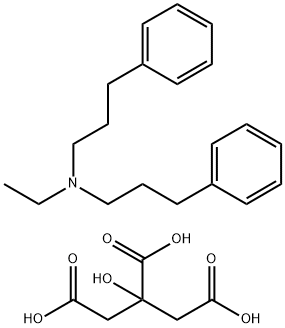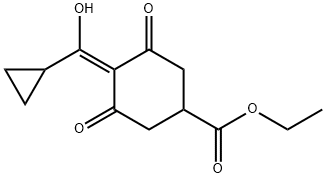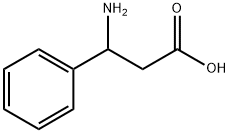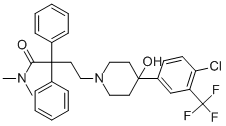Alverine
- CAS NO.:150-59-4
- Empirical Formula: C20H27N
- Molecular Weight: 281.44
- MDL number: MFCD00075035
- EINECS: 205-763-5
- SAFETY DATA SHEET (SDS)
- Update Date: 2023-05-21 10:59:17

What is Alverine?
Toxicity
Can produce hypotension and atropine-like toxic effects. Fatality has occurred following overdose with very high doses.
Originator
Alverine citrate,Kemikos
The Uses of Alverine
Anticholinergic.
Indications
Used to relieve cramps or spasms of the stomach and intestines. It is also useful in treating irritable bowel syndrome (IBS) and similar conditions. It can also be used to help relieve period pain. Alverine citrate is also under investigation to increase the cytotoxic effects of the proteasome inhibitor MG132 on breast cancer cells.
Definition
ChEBI: A tertiary amine having one ethyl and two 3-phenylprop-1-yl groups attached to the nitrogen. An antispasmodic that acts directly on intestinal and uterine smooth muscle, it is used (particularly as the citrate salt) in the treatment of irritable bowel synd ome.
Background
Alverine is a smooth muscle relaxant used to relieve cramps or spasms of the stomach and intestines. It is therefore useful in treating irritable bowel syndrome (IBS) and similar conditions. It can also be used to help relieve period pain.
Manufacturing Process
2 Methods of producing of alverine:
1. 3-Phenylpropylchloride reacted with ethylamine in the presence potassium
hydroxide and N-ethyl-3,3'-diphenyldipropylamine (alverine) was obtained.
2. 3-Phenylpropenal reacted with ethylamine in the presence hydrogen and Pt
as catalyst and BaSO4 and N-ethyl-3,3'-diphenyldipropylamine (alverine) was
obtained.
In practice it is usually used as citrate.
Therapeutic Function
Anticholinergic, Spasmolytic
Pharmacokinetics
Alverine is a smooth muscle relaxant. Smooth muscle is a type of muscle that is not under voluntary control; it is the muscle present in places such as the gut and uterus. Alverine acts directly on the muscle in the gut, causing it to relax. This prevents the muscle spasms which occur in the gut in conditions such as irritable bowel syndrome and diverticular disease. Diverticular disease is a condition in which small pouches form in the gut lining. These pouches can trap particles of food and become inflamed and painful. In irritable bowel syndrome the normal activity of the gut muscle is lost. The muscle spasms result in symptoms such as heartburn, abdominal pain and bloating, constipation or diarrhoea. By relaxing the gut muscle, alverine citrate relieves the symptoms of this condition. Alverine also relaxes the smooth muscle in the womb (uterus). It is therefore also used to treat painful menstruation, which is caused by muscle spasms in the uterus (dysmenorrhea).
Metabolism
Rapidly converted to its primary active metabolite, which is then further converted to two secondary metabolites.
Properties of Alverine
| Melting point: | <25 °C |
| Boiling point: | bp0.3 165-168°; bp13 210-215° |
| Density | 0.973±0.06 g/cm3(Predicted) |
| storage temp. | Store at -20°C |
| pka | 9.51±0.50(Predicted) |
| NIST Chemistry Reference | Benzenepropanamine, n-ethyl-n-(3-phenylpropyl)-(150-59-4) |
Safety information for Alverine
| Signal word | Warning |
| Pictogram(s) |
 Exclamation Mark Irritant GHS07 |
| GHS Hazard Statements |
H317:Sensitisation, Skin H319:Serious eye damage/eye irritation |
| Precautionary Statement Codes |
P280:Wear protective gloves/protective clothing/eye protection/face protection. P305+P351+P338:IF IN EYES: Rinse cautiously with water for several minutes. Remove contact lenses, if present and easy to do. Continuerinsing. |
Computed Descriptors for Alverine
New Products
Tert-butyl bis(2-chloroethyl)carbamate (S)-3-Aminobutanenitrile hydrochloride N-Boc-D-alaninol N-BOC-D/L-ALANINOL N-octanoyl benzotriazole 4-Hydrazinobenzoic acid 3,4-Dibenzyloxybenzaldehyde 1,1’-CARBONYLDIIMIDAZOLE R-2-BENZYLOXY PROPIONIC ACID 1,1’-CARBONYLDI (1,2-4 TRIAZOLE) 4-HYDROXY BENZYL ALCOHOL 3-NITRO-2-METHYL ANILINE (2-Hydroxyphenyl)acetonitrile 4-Bromopyrazole 5-BROMO-2CYANO PYRIDINE 5,6-Dimethoxyindanone 5-broMo-2-chloro-N-cyclopentylpyriMidin-4-aMine 4-methoxy-3,5-dinitropyridine 2-(Cyanocyclohexyl)acetic acid 2-aminopropyl benzoate hydrochloride 1-(4-(aminomethyl)benzyl)urea hydrochloride tert-butyl 4- (ureidomethyl)benzylcarbamate diethyl 2-(2-((tertbutoxycarbonyl)amino) ethyl)malonate Ethyl-2-chloro((4-methoxyphenyl)hydrazono)acetateRelated products of tetrahydrofuran








You may like
-
 873-83-6 6-Aminouracil (or) 4-Amino-2,6- dihydroxypyrimidine, (or) 6-Amino2,4-pyrimidinediol 99%View Details
873-83-6 6-Aminouracil (or) 4-Amino-2,6- dihydroxypyrimidine, (or) 6-Amino2,4-pyrimidinediol 99%View Details
873-83-6 -
 55441-95-7 99%View Details
55441-95-7 99%View Details
55441-95-7 -
 N-Vinylformamide 99%View Details
N-Vinylformamide 99%View Details
13162-05-5 -
 Chloro Uracil 1820-81-1 99%View Details
Chloro Uracil 1820-81-1 99%View Details
1820-81-1 -
 207557-35-5 99%View Details
207557-35-5 99%View Details
207557-35-5 -
 2-ethyl-6-methyl-3-hydroxypyridine succinate 99%View Details
2-ethyl-6-methyl-3-hydroxypyridine succinate 99%View Details
127464-43-1 -
 2-ETHYLPYRIDINE 100-71-0 99%View Details
2-ETHYLPYRIDINE 100-71-0 99%View Details
100-71-0 -
 181228-33-1 (S)-Methyl 3-amino-2-((tert-butoxycarbonyl)amino)propanote Hydrochloride (DAP-OMe. HCl) 99%View Details
181228-33-1 (S)-Methyl 3-amino-2-((tert-butoxycarbonyl)amino)propanote Hydrochloride (DAP-OMe. HCl) 99%View Details
181228-33-1